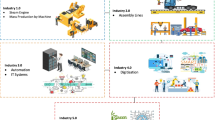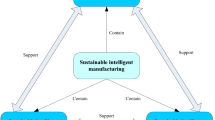Abstract
Automotive general assembly requires many manual assembly operations to be carried out by human workers. Ergonomic analysis is an important part of the design and evaluation of products, jobs, tools, machines and environments for safe, comfortable and effective human functioning. Most recent researches have involved the evaluation of working conditions to prevent work-related musculoskeletal disorders. The majority of previous research on automotive companies has mainly considered the results of ergonomic analyses such as RULA (Rapid Upper Limb Assessment), REBA (Rapid Entire Body Assessment) and OWAS (Ovako Working Posture Analysis System). Analysis of static posture including reachability, clearances for arm, hand and tool has also been used to evaluate working conditions. However, in addition to static posture analysis, a biomechanical analysis in dynamic conditions should also be conducted. There are no integrated frameworks or standard schema for ergonomic analysis using digital human models in digital environments. The purpose of this paper is to propose a new framework for the evaluation of working conditions by ergonomic and biomechanical analysis using digital models based on XML standard schema, including: products, processes, manufacturing resources and human workers. This paper presents the analysis results using the proposed framework for automotive general assembly operations. We propose a new framework for the evaluation of the assembly operations and their environments. Then we apply a digital human model to the dynamic simulation of general automotive assembly operations based on standard schemas in XML and PPRH (Product, Process, Resource and Human). Using PPRH information based on a standard XML schema to analyze the ergonomic and biomechanical results, the engineer can visualize, analyze and improve assembly operations and working environments in automotive general assembly shops using digital models.
Similar content being viewed by others
References
Badler, N. (1993). Computer Graphics Animation and Control, Simulating Humans. Oxford University Press. New York.
Chaffin, D. (1969). A computerized biomechanical model: Development and use in studying gross body actions. J. Biomechanics, 2, 429–441.
Chaffin, D. B. (2007). Human motion simulation for vehicle and workplace design. Human Factors and Ergonomics in Manufacturing 17,5, 475–484.
Chang, S.-W. and Wang, M.-J. J. (2007). Digital human modeling and workplace evaluation: Using an automobile assembly task as an example. Human Factors and Ergonomics in Manufacturing 17,5, 445–455.
Denavit, J. and Hartenberg, H. (1955). A kinematic notation for lower-pair mechanisms based on matrices. J. Applied Mechanics, 21, 215–221.
Engineering Animation (2004). Jack Version 2.x Training Course Note. MI. USA.
Hendrick, H. W. (2000). The technology of ergonomics. Theoretical Issues in Ergonomics Science 1,1, 22–33.
Kazmierczak, K., Neumann, W. P. and Winkel, J. (2007). A case study of serial-flow car disassembly: Ergonomics, productivity and potential system performance. Human Factors and Ergonomics in Manufacturing 17,4, 331–351.
Kim, G. Y., Noh, S. D., Rim, Y. H., and Mun, J. H. (2008). XML-based concurrent and integrated ergonomic analysis in PLM. Int. J. Advanced Manufacturing Technology, 39, 1045–1060.
Kingma, I., DeLooze, M. P., Toussaint, H. M., Klijnsma, H. G. and Bruijnen, T. B. M. (1996). Validation of a full body 3-D dynamic linked segment model. Human Movement Science, 15, 833–860.
Lämkull, D., Hanson, L. and Örtengren, R. (2007). The influence of virtual human model appearance on visual ergonomics posture evaluation. Applied Ergonomics, 38, 713–722.
Maynard, H. B., Stegemerten, G. J. and Schwab, J. L. (1948). Method-Time Measurement. McGraw-Hill. New York.
Noh, S. D., Park, Y. J., Kong, S. H., Han, Y. G., Kim, G., and Lee, K. I. (2005). Concurrent and collaborative process planning for automotive general assembly. Int. J. Advanced Manufacturing Technology, 26, 572–584.
Noh, S. D. and Kim, G. (2006). Collaborative process and flow analysis for automotive assembly shops. Int. J. Automotive Technology 7,2, 217–226.
Noh, S. D., Park, Y. J., Kong, S. H., Han, Y. G., Kim, G. and Lee, K. I. (2005). Concurrence and collaborative process planning for automotive general assembly. Int. J. Advanced Manufacturing Technology, 26, 572–584.
Santos, J., Sarriegi, J. M., Serrano, N. and Torres, J. M. (2007). Using ergonomic software in non-repetitive manufacturing processes: A case study. Int. J. Industrial Ergonomics, 37, 267–275.
Seidle, A. (1997). Ramsis-A new cad tool for ergonomic analysis of vehicles developed for the german automotive industry. SAE Paper No. 970088.
Shan, G. and Bohn, C. (2003). Anthropometrical data and coefficients of regression related to gender and race. Applied Ergonomics 34,4, 327–337.
Tolani, D., Goswami, A. and Badler, N. I. (2000). Real-time inverse kinematics techniques for anthropomorphic limbs. Graphical Models, 62, 353–388.
Author information
Authors and Affiliations
Corresponding author
Rights and permissions
About this article
Cite this article
Rim, Y.H., Moon, J.H., Kim, G.Y. et al. Ergonomic and biomechnical analysis of automotive general assembly using XML and digital human models. Int.J Automot. Technol. 9, 719–728 (2008). https://doi.org/10.1007/s12239-008-0085-7
Received:
Revised:
Published:
Issue Date:
DOI: https://doi.org/10.1007/s12239-008-0085-7




